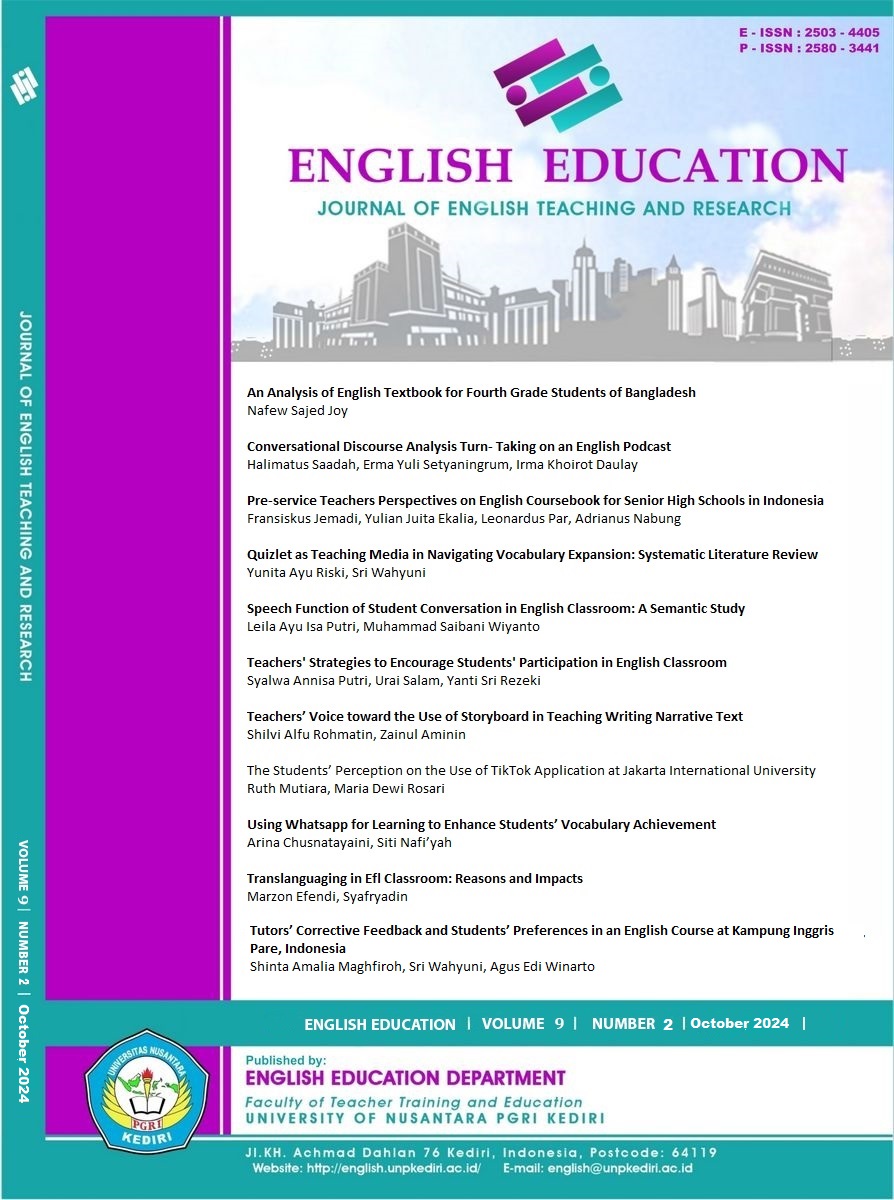Pre-service Teachers Perspectives on English Coursebook for Senior High Schools in Indonesia
DOI:
https://doi.org/10.29407/jetar.v9i2.21540Keywords:
Textbook evaluation; Perception; Teachers’ perceptions, Textbook evaluationAbstract
A textbook is an inseparable part of the teaching and learning process. This research was aimed at discovering pre-service teachers’ perception of the ELT textbook, Buku Bahasa Inggris for Students grade XI. This qualitative study involved 18 pre-service teachers who were doing their teaching practicum in different senior high schools in Manggarai, East Nusa Tenggara Province. They were chosen purposefully by the researchers and voluntarily engaged in semi-structured interviews to discover their perspectives on the English textbook they used during their teaching practicum. The results showed that they had mixed opinions about their textbooks, ranging from positive to negative, depending on various factors such as their learning objectives, preferences, expectations, and experiences. The observations and conclusions from this study may be useful for educators and coursebook designers in developing English coursebooks that can improve students' motivation, engagement and language learning outcomes.
Downloads
References
2. Awasthi, J. R., Sharma, K. C., Dahala, H. R., Pathak, L. S., & Poudel, K. (2006). Textbook and its evaluation. Journal of NELTA, 11(1-2), 1-10.
3. Bahman, M., &Rahimi. 2010. Gender Representation n EFL Materials: an analysis of English textbooks of Iranian high school. ScienceDirect Journal Volume 9/273-277.Procedia Social and Behavioral Sciences
4. Brown, H. D. (2004). Language assessment: Principles and practice. Pearson Education.
5. Cameron, D. 1985. Feminism and Linguistic Theory. London: Macmillan.
6. Cunningsworth, A. (1995) Choosing your coursebook. Oxford: Macmillan Heinemann English Language Teaching.
7. Fraenkel, J. R., Wallen, N. E., & Hyun, H. H. 2012. How to Design and Evaluate Research in Education (Eight Edition). New York: McGram-Hill Companies.
8. Hutchinson, T., & Torres, E. (1994). The textbook as agent of change.
9. Karsudianto, F. (2019). An evaluation of an English coursebook †œWhen English Rings The Bellâ€. Journal of English Language Teaching Innovations and Materials (JELTIM), 1(2), 81-86.
10. Kim, Y., & McDonough, S. H. (2012). The effects of cultural information in EFL textbooks on Korean EFL learners' cultural awareness and understanding of real-life contexts. Language Teaching Research, 16(1), 53-73.
11. Le, T., Le, M., & Nguyen, Q. (2021). EFL Teachers' Evaluation on “Skillful-Teaching Writing and Reading 02”. FOSTER: Journal of English Language Teaching, 2(3), 398-417.
12. Lee, L., & Huang, J. (2010). The effect of interactive and engaging activities on EFL learners' motivation and learning outcomes. Journal of Language Teaching and Research, 1(1), 1-12.
13. Mahmood, K. (2009). Indicators for a quality textbook evaluation process in Pakistan. Journal of Research and Reflections in Education, 3(2), 158–176. https://pdfs.semanticscholar.org/9637/9ef32504c010d596e7319fea023efefc75d8.pdf. Search in Google Scholar
14. Mills, S. (1995). Feminist stylistic. London: Routledge.
15. Nimehchisalem, V., & Mukundan, J. (2015). Refinement of the English Language Teaching Textbook Evaluation Checklist. Pertanika Journal of Social Sciences & Humanities, 23(4).
16. Purnomowulan, S. (2014). Content analysis of an English textbook entitled Bahasa Inggris “When English Rings a Bell”. Jurnal Ilmiah Mahasiswa Universitas Surabaya.
17. Reid, G., Soler, J., & Wearmouth, J. (2014). Contextualising difficulties in literacy development: exploring politics, culture, ethnicity and ethics. Routledge.
18. Richards, J. C. (2001). The Role of Textbooks in Language Program. Cambridge University Press.
19. Satriani, I., & Resmini, S. (2021). ESP Coursebook Evaluation: Students’ Perception on Activities and Tasks. ELT in Focus, 4(1), 20-25.
20. Setiawan, W. (2021). Evaluation On An English Coursebook In Online Learning: Voices From Teachers. English Review: Journal of English Education, 9(2), 453-462.
21. Solangi & Memon (2020). Evalution of ‘English for Undergraduates’- a course-book for English Language Teaching at University of Sindh, Jamshoro, Pakistan from Teachers' Perspectives. Research on Humanities and Social Sciences; Vol 10, No 22 (2020); 60-69 (2020-12-04) [link]: https://www.iiste.org/Journals/index.php/RHSS/article/view/54910
22. Solhi, M., Meryem, S. A. K., Şahin, Ş., & YILMAZ, S. (2020). Evaluation of the English language coursebooks used at the Turkish public elementary schools. Journal of Language and Linguistic Studies, 16(3), 1282-1308.
23. Supriyanto, N. H. (2019). An Evaluation Of English Coursebook For Young Learners Entitled English Chest. Magister Scientiae, 2(46), 145-182.
24. Tomlinson, B. (ed.) (1998) Materials development in language teaching. Cambridge: Cambridge University Press.
25. Tomlinson, B. (2016). The importance of materials development for language learning. In Issues in materials development (pp. 1-9). Brill Sense.
26. Tomlinson, B. (2013). Introduction: Are materials developing? In B. Tomlinson (Eds.), Developing materials for language teaching (pp. 1-17). Bloomsbury Publishing Plc.
27. Tomlinson, B., & Masuhara, H. (2013). Adult coursebooks. ELT Journal, 67(2), 233-249.
28. Tyas, P. A., & Safitri, M. (2019). An Analysis of English Textbook Entitled" Bahasa Inggris SMA/MA SMK/MAK Kelas X". JEES (Journal of English Educators Society), 4(1), 17-22.
Downloads
Published
Issue
Section
License
Authors who publish with this journal agree to the following terms:
- Copyright on any article is retained by the author(s).
- The author grants the journal, the right of first publication with the work simultaneously licensed under a Creative Commons Attribution License that allows others to share the work with an acknowledgment of the work’s authorship and initial publication in this journal.
- Authors are able to enter into separate, additional contractual arrangements for the non-exclusive distribution of the journal’s published version of the work (e.g., post it to an institutional repository or publish it in a book), with an acknowledgment of its initial publication in this journal.
- Authors are permitted and encouraged to post their work online (e.g., in institutional repositories or on their website) prior to and during the submission process, as it can lead to productive exchanges, as well as earlier and greater citation of published work.
- The article and any associated published material is distributed under the Creative Commons Attribution-ShareAlike 4.0 International License








 Article template
Article template



